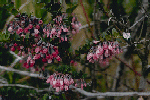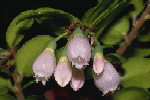Reference: SLEUMER, H. O., Die Arten der Gattung Vaccinium L. in Zentral- und Sudamerika. Notizbl. Bot. Gart. Berlin-Dahlem 13: 111--140 (1936).


Shrubs or rarely trees, often rhizomatous. Leaves alternate, persistent or deciduous, margin entire or serrate, usually pinnately nerved, rarely plinerved, petiole short. Inflorescence axillary, developing from the buds of the previous season, racemose or rarely only 1--2-flowered, the flowers borne in the axil of the floral bract or a leaf; pedicel usually bibracteolate. Flowers 4--5-merous, usually without odor; aestivation imbricate (V. crenatum , V. floribundum ); calyx articulate with the pedicel (in Ecuador) or continuous; hypanthium cylindric to globose; lobes rarely obsolete; corolla gamopetalous, cylindric, urceolate, or campanulate, white, greenish, red or yellowish, the lobes rarely parted almost to the base; stamen 8 or 10, equal, about equalling corolla; filaments distinct, longer than the anthers, with or without spurs, sometimes (in V. floribundum ) with apparently vestigial spurs; anthers lacking disintegration tissue; thecae smooth or papillate; tubules dehiscing by terminal pores or rarely oblique clefts; pollen without viscin strands; ovary completely or partly inferior, 4--5 (-falsely 10)-locular; stigma small, simple or somewhat capitate. Fruit a berry, 5--many seeded, crowned by the persistent calyx lobes and capped by the conspicuous nectariferous disc; seeds sometimes with mucilaginous sheath.
Vaccinium is a genus of perhaps 300 species primarily of the Northern Hemisphere, mostly montane in the tropics; three species are found in Ecuador.